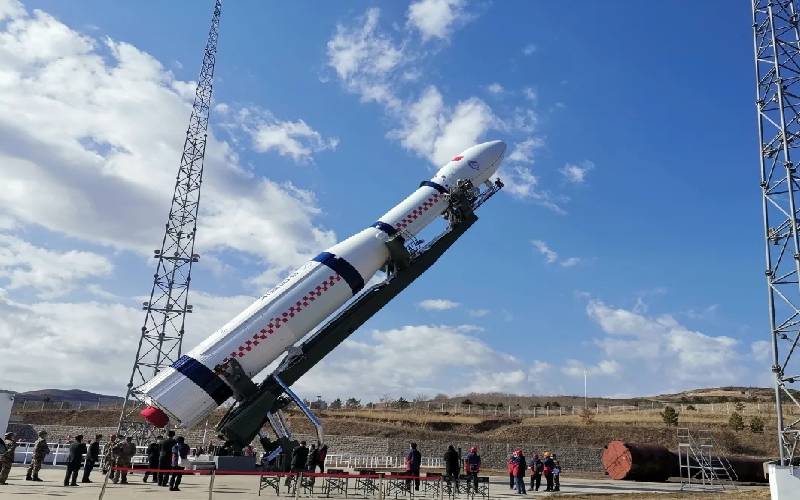
In November, China launched an Earth science satellite called Guangmu (SDGSAT-1) of roughly around 740 kilogrammes into space from the Taiyuan Satellite Launch Centre in the northern Shanxi Province.
The satellite was launched through a Long March-6 carrier rocket. The launch was the 395th flight mission of the Long March rocket series. The Shanghai Academy of Spaceflight Technology (SAST) was developed long March-6 in 2015, the same year it was launched. Since then, it has launched eight times in total. The rocket has played an important role in China’s launch missions. It uses, unlike older Long March rockets, very refined kerosene and liquid oxygen propellant.
The satellite is designed to orbit at an altitude of somewhere around 505 kilometres. It has thermal infrared, low light level and multispectral cameras to collect the data.
The satellite was developed by the Chinese Academy of Science (CAS). According to the academy, the satellite has three optical payloads in it and can provide space observation data for studying, evaluating, and monitoring the interconnection between humans and nature and sustainable development. The satellite started as part of the Chinese Academy of Science’s project on Big Earth Data Science Engineering and was earlier known as the CAS Earth satellite. According to the CAS 2020 paper on the progress of the satellite, data services from the satellite will be made available within half-year of the launch.
It is a first-of-its-kind satellite. It is the world’s first space science satellite dedicated to the UN 2030 Agenda for Sustainable Development. The UN 2030 Agenda is an action plan for people, the planet and prosperity. It aims to further universal peace in larger freedom. Through the agenda, the UN has resolved to free people from poverty and to hear and secure the planet.
Belt and Road Initiative
Sustainable development in China has been a challenge for a long time. The growth of China to a major global economic force has got with it many negative consequences as well such as the increase in inequality gap and environmental degradation. Environmental degradation is a big issue as the economic growth of China is based on the use of coal and other fossil fuels. China became the world’s largest greenhouse gas emitter.
Recently, China introduced the Belt and Road Initiative (BRI) to help countries in breaking the bottlenecks of development and get the benefit of global value, industrial and supply chains.
That means, according to China, investing in infrastructure connectivity to permit more industrial trading and production will reduce poverty by making available enough money to buy food. No poverty and zero hunger are the two primary goals of the UN 2030 Agenda for Sustainable Development.
According to China, the BRI is meant to support sustainable development by incorporating economic, social and environmental considerations. For instance, green development was emphasized at the Belt and Road Forum in 2019. However, in practice, China complies with the host country principles which means local laws need to be adhered to and the local governments have the right to decide on all matters of the project, keeping global standards secondary. Consequently, if a local government wants to build coal-based or solar power plants, China will support both.
Although China has been preaching for sustainable development, there is a stark difference in practice.
Over the years, China’s GDP has increased considerably which has lifted billions of people out of poverty. However, data suggests that disparity between the rich and poor is on the rise everywhere.
The Chinese idea of sustainable development is strengthening economic development. However, economic development would lead to an increase in sustainability problems than solutions.
China’s progress of 2030 sustainable development goals, especially health-related, has remained unimpressive and requires effective policy interventions, vaccines, new drugs and other technologies and increased public spending, it will be hard for China to achieve all the health-related sustainable development targets.
Stay informed. Subscribe to our newsletter
Sustainable development is about maximising the satisfaction of the people with the least impact on the environment, ecology and other parts of the atmosphere. The time has come when China realises that sustainable development is not just strengthening economic development instead there are many facets to it that are required to be balanced. There is still a lot to be done to achieve the global commitment to sustainable development.
 The Standard Group Plc is a
multi-media organization with investments in media platforms spanning newspaper
print operations, television, radio broadcasting, digital and online services. The
Standard Group is recognized as a leading multi-media house in Kenya with a key
influence in matters of national and international interest.
The Standard Group Plc is a
multi-media organization with investments in media platforms spanning newspaper
print operations, television, radio broadcasting, digital and online services. The
Standard Group is recognized as a leading multi-media house in Kenya with a key
influence in matters of national and international interest.
 The Standard Group Plc is a
multi-media organization with investments in media platforms spanning newspaper
print operations, television, radio broadcasting, digital and online services. The
Standard Group is recognized as a leading multi-media house in Kenya with a key
influence in matters of national and international interest.
The Standard Group Plc is a
multi-media organization with investments in media platforms spanning newspaper
print operations, television, radio broadcasting, digital and online services. The
Standard Group is recognized as a leading multi-media house in Kenya with a key
influence in matters of national and international interest.







